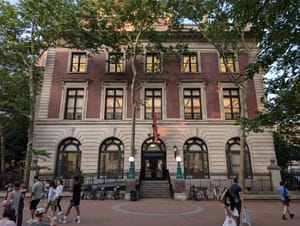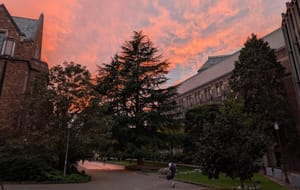It would be interesting to take a fuller discussion in one of two directions, which would fill in more individual or organizational names. The first is empirical, based on survey, citations, and other markers of influence. A second would be to be more opinionated, which would be partial (in more than one sense) but might prompt some reflection about emphasis and omission.
If you wish to reference it, I would be grateful if you cite the full original: Dempsey, L. (2025). Library Studies, the Informational Disciplines, and the iSchool: Some Remarks Prompted by LIS Forward. In LIS Forward (2025) Responses to the LIS Forward Position Paper: Ensuring a Vibrant Future for LIS in iSchools, The Friday Harbor Papers, Volume 2. [pdf]
The diffusion of ideas
As numerous critics beyond Kristof have observed, the professionalization of the academy prioritizes peer-reviewed publications over other forms of writing. Professors allocate the bulk of their efforts to researching, writing, and publishing in their field journals. The first task of any professor—particularly junior professors—is to publish in prestigious peer-reviewed outlets. Even scholars who have some facility with engaging a wider audience have warned that it takes time away from research.49 It is great when academics also express their ideas to a wider audience. Professional incentives dictate, however, that this will always be the hobby and not the job. // Daniel W. Drezner (2017) The Ideas Industry.
The university plays an important role in the generation and diffusion of ideas and innovation. The Report does not focus on this area. However, informing practice and influencing policy is an important part of what the university does, especially in a practice-oriented discipline. As noted, in a period of change, libraries benefit from data-based frameworks, evidence, and arguments to support advocacy work, or to think about new service areas. In a related context, being interviewed on NPR when expertise is required or writing an op-ed in a leading newspaper are markers of esteem (see the discussion of symbolic capital in the next section).
... in a period of change, libraries benefit from data-based frameworks, evidence, and arguments to support advocacy work, or to think about new service areas.
Drezner’s typology of sources
Dan Drezner writes about the dissemination of ideas in The Ideas Industry. Drezner is interested in how ideas are diffused and taken up in political and policy contexts, and how they lead to action or practical decisions. He discusses the evolving sources of ideas in the policy arena.
- Academic. The academy may have been the historically primary source of ideas, although Drezner argues that its influence has waned for various reasons. He notes the scholarly incentives of faculty, which promote peer-reviewed articles in leading journals as the peak achievement, and which in turn leads to disciplinary peers as the primary audience and community they seek. Disciplines will have different dynamics. For example, perhaps because of its normative base, Drezner suggests, economics has more influence than other social sciences.
- Think tanks. He charts the rise and changing role of think tanks such as the Rand Corporation or Brookings Institution. Unlike universities, these do have an explicit role in influencing policy, and over time some have become more partisan.
- Industry and management consulting. Various firms – McKinsey, Gartner, and others – have developed capacity for published research and thought pieces, often as a form of reputational promotion of their consulting or related services.
- Individuals. Drezner highlights, for example, the careers of Fareed Zakaria and Neil Ferguson.
How does this play out in the library field?
The incentives Drezner mentions are strongly at play in R1 schools and may not be aligned with broader community engagement. This is evident in the comments of the Early Career Researchers. Of course, taken collectively iSchools do work which influences both practice and policy, and there are some notable connections (Sheffield and exploration of open access, for example). There are also some high-profile iSchool faculty members who make important and visible contributions to broader debate outside the library context.
While they are not think-tanks as such, one can point to Ithaka S&R and OCLC Research, divisions, respectively, of large not-for-profit service organizations, each of which is quite active in working with groups of libraries to develop applied R&D outputs.[1] They tend to focus on areas of topical interest, such as collections, collaboration, research infrastructure and scholarly communication. Over the years, they have worked on a variety of topics (including, for example, metadata and protocols, research support, library collaboration, and user behavior in the case of OCLC Research). Ithaka S&R has an academic and cultural focus. OCLC Research works with academic and public libraries (notably through WebJunction, a learning platform for libraries). In each case, there is definitely an interest in providing knowledge, evidence and models that help influence practice or inform policy.
This interest is also evident in the output of professional associations and others which produce outputs on behalf of members. While different from Drezner’s consultancy category, there are some parallels in terms of providing value to members. Here one might point to the Urban Libraries Council or to the Association for Research Libraries and the Coalition for Network Information, or to the divisions of ALA. ARSL is another example.
Advocacy and other groups also produce materials to inform and guide. Helping with evidence and arguments is important here. SPARC and EveryLibrary are examples.
An important element of what associations and membership groups do is to provide venues for networking and to support communities of practice. They aim to scale learning and innovation within their constituencies.
An important element of what associations and membership groups do is to provide venues for networking and to support communities of practice. They aim to scale learning and innovation within their constituencies.
One can also see that vendors produce occasional reports, as a value-add to customers. Think of Sage or Clarivate for example. In some cases, these may not be seen as more than elevated marketing.
Finally, there is a variety of individual practitioner voices that are quite influential.
I have not given a lot of examples above, because without some analysis, it would be very subjective. However, some exploration of the diffusion of ideas and innovation in this space would be interesting, acknowledging that it is a smaller more tight-knit community than some of the areas Drezner (who is a scholar and commentator of International Relations) discusses.
Public intellectuals and thought leaders
Public intellectuals delight in taking issue with various parts of the conventional wisdom. By their very nature, however, they will be reluctant to proffer alternative ideas that appeal to any mass audience. Thought leaders will have no such difficulty promising that their ideas will disrupt or transform the status quo. And the shifts discussed in this chapter only increase the craving for clear, appealing answers. // Daniel W. Drezner (2017) The Ideas Industry.
This is an inherent tension between scholarship and communication, one that breeds resentment for academics trying to engage a wider audience as well as readers who have to wade through complex, cautious prose. Daniel W. Drezner (2017) The Ideas Industry.
In Drezner’s terms, thought leaders favor large explanatory ideas, and deliberately aim to influence policy and practice. They value clear communication, may view the world through a single frame, and evangelize their ideas actively. Thomas Friedman is an example in the book. Public intellectuals promote critical thought across different arenas, may not offer easy solutions or answers, and emphasize complexity and questioning. Francis Fukuyama and Noam Chomsky are cited examples here.
Drezner notes that the current climate favors thought leaders because their ideas are easier to consume: their big idea can be delivered in a Ted Talk. Perhaps the library community hit peak thought leadership in the heyday of the personal blog, where several influential librarians achieved large audiences.
Platform publications
Computing has Communications of the ACM. Engineering has IEEE Spectrum. Business readers turn to the Harvard Business Review. The HE technology community has Educause Review.
These are what I have called in the past ‘platform’ publications (Dempsey and Walter). They aggregate the attention of an audience within a particular domain, including leadership, practice and research. They provide a platform for their authors, who may be reasonably assured of a broad engaged audience.
The library community does not have such a publication, which could provide a venue for research and practice to co-exist in dialog.
Ischools and influence on policy and practice
What is the role of the iSchool in influencing policy and informing practice? More specifically, how important is it for Library Studies to visibly do this?
The bilateral research - practice connection is of course much discussed, and I wondered about the gap here above. Is the influence on policy at various levels perhaps less discussed?
This works in a variety of ways, not least through participation in professional venues – membership of associations, presentation where practitioners congregate to learn about direction, partnership with library organizations and libraries.
Again, without supporting evidence, my impression is that there may be a higher level of engagement with policy and practice in Archival Studies than in Library Studies when measured against overall research and education capacity.
I believe that markers of influence are important for elevating the overall profile of Library Studies, and that the initiative should look at this engagement in a further iteration of this work. A comparative perspective would be interesting, thinking firstly of the LAM strands, and then of other practice-oriented disciplines. How do library studies perform in terms of impact on policy/practice compared to other comparable disciplines?
This seems especially important now, given the importance of evidence and arguments in a time of contested value and values.
Coda: overview of and links to full contribution
Collection: LIS Forward (2025) Responses to the LIS Forward Position Paper: Ensuring a Vibrant Future for LIS in iSchools, The Friday Harbor Papers, Volume 2. [pdf]
Contribution: Dempsey, L. (2025). Library Studies, the Informational Disciplines, and the iSchool: Some Remarks Prompted by LIS Forward. In LIS Forward (2025) Responses to the LIS Forward Position Paper: Ensuring a Vibrant Future for LIS in iSchools, The Friday Harbor Papers, Volume 2. [pdf]
Contents: Here are the sections from my contribution. Where I have excerpted them on this site, I provide a link.
- 1 Introduction [and summary] [excerpted here]
- 2 Information: a brief schematic history [excerpted here]
- 3 Libraries and library studies [excerpted here]
- 4 Informational disciplines [excerpted here]
- 5 On the dissemination of ideas and innovation [excerpted here]
- 6 Symbolic capital
- 7 Recommendations and candidate recommendations
- Coda 1: Google Ngram
- Coda 2: Personal position
- References
[1] Buschman (2020) talks about ‘white papers’ in the library space, and, focusing attention on the outputs of Ithaka S&R, describes them as ‘empty calories.’
References
Buschman, J. (2020). Empty calories? A fragment on LIS white papers and the political sociology of LIS elites. The Journal of Academic Librarianship, 46(5), 102215. https://doi.org/10.1016/j.acalib.2020.102215
Dempsey, L., & Walter, S. (2014). A platform publication for a time of accelerating change. College and Research Libraries, 75(6), 760–762. https://doi.org/10.5860/crl.75.6.760
Drezner, D. W. (2017). The Ideas Industry: How Pessimists, Partisans, and Plutocrats are Transforming the Marketplace of Ideas. Oxford University Press.
Feature picture: I took the picture in NYC.



